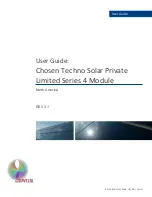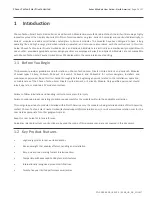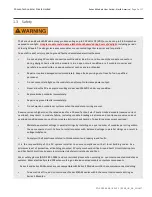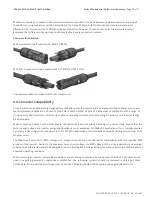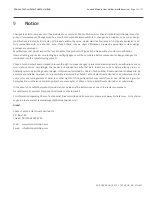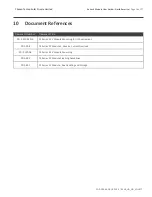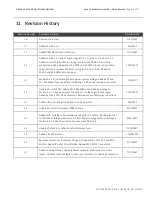
Series 4 Module User Guide—North America
| Page 7 of 17
Installation locations and module support structures should be selected to ensure modules and connectors (open or mated) are
never submersed in standing water. Chosen Techno Solar Private Limited modules are tested and certified for applications
involving pressures from snow/ice/wind up to 2400 Pa (50.13 lb/ft
2
) when mounted properly. Snow drifts could result in a
nonuni form loading of the modules which exceeds the tested pressure. If it is expected that loads will exceed 2400 Pa (50.13
lb/ft
2
),
it is recommended to clear snow from modules, and ensure that ice/thaw/freeze cycles under snow drifts do not result in
excessive stresses on the module.
Heavy construction and trenching should be completed prior to module installation to minimize debris and dust.
Ensure any site preparation or maintenance chemicals (soil binding agents or chemicals used for on-site dust control or weed
control) do not spray, splash, or drift onto the surface of the modules or its associated components.
The UL approved design load of Series 4 and Series 4A Modules is 30 lb/ft
2
(1436 Pa).
Maximum allowable pressure on modules may not exceed 2400 Pa (50.13 lb/ft
2
) without additional module support that
must be tested and approved by Chosen Techno Solar Private Limited to receive a project specific approval.
For rooftop mounting, modules must be mounted over a fire resistant roof covering rated for the application. The
recommended minimum standoff height is 3.25 in (82.55 mm). Modules used in UL Listed rooftop applications must be
installed with approved mounting systems. If alternate mounting means are employed, this may affect the Listing fire class
ratings and additional UL fire testing may be required. The fire rating of this module is valid only when mounted in the
manner specified in the mechanical mounting instructions.
4.1.1 Series 4A Module Installation Considerations (with Anti-Reflective Coating)
Handle with gloves to preserve visual appearance of anti-reflective coated modules (Series 4A).
During handling and installation, avoid abrasive contact with top glass surface to prevent scratches of anti-reflective coating on
Series 4A modules.
Do not remove cardboard separator paper before removing modules from box. Doing so may result in scratches of the ARC
film when pulling modules out of the box.
When cleaning Anti-Reflective Coated modules, specific module cleaning guidelines documented in PD-5-804 Module Cleaning
Guidelines must be followed. Failure to comply with the Module Cleaning Guidelines may void warranty.
Basic cleaning guidelines for Anti-Reflective Coated modules are as follows:
Allowable Cleaning Methods
•
Low pressure
non-contact
water cleaning may be used with unlimited cycles (i.e. water spray is allowed, but scrubbing or
brushing with water is prohibited).
•
Dry cleaning with soft cloth mops up to six times annually
Prohibited Cleaning Methods
•
Wet contact cleaning (i.e. combining water with mops, brushes, squeegees)
•
Dry contact cleaning with anything other than soft cloths or mops (i.e. bristle brushes, sponges, or squeegees).
PD-5-200-04 NA | REV 3.1 | 0348_UG_NA_11JUL17
Chosen Techno Solar Private Limited

